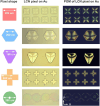Micropatterned Liquid Crystalline Networks for Multipurpose Color Pixels
- PMID: 39904494
- PMCID: PMC11843605
- DOI: 10.1021/acsami.4c20865
Micropatterned Liquid Crystalline Networks for Multipurpose Color Pixels
Abstract
Materials that can visually report changes in the surrounding environments are essential for future portable sensors that monitor temperature and detect hazardous chemicals. Ideal responsive materials for optical sensors are defined by a rapid response and readout, high selectivity, the ability to operate at room temperature, and simple microfabrication. However, because of the lack of viable materials and approaches, compact, passive, and multipurpose practical devices are still beyond reach. To address this challenge, we develop a methodology to fabricate colored and responsive micropixels printed by digital light projection lithography on gold substrates. These structures are made by polymeric Liquid Crystalline Networks (LCNs) whose birefringence and external stimuli responsiveness allow for micrometric devices with visual and fast response that we here apply to a few applications. First, we show how varying the projected geometrical shape can become an effective tool to engineer symmetric disclination lines in the liquid crystal order. Depending on the thickness of the micropixels, LCNs give rise to a birefringence color under polarized light or a structural color under white light due to thin-film interference. By exposing the micropatterns to temperature variation and solvents, we demonstrate a real-time optical temperature detection and differentiation between selected organic chemicals. The proposed materials and fabrication method could be scaled up and extended to roll-to-roll printing, enabling future real-life applications of liquid crystalline polymers in affordable microdevices and optical sensors with a net advantage with respect to traditional lithographic techniques in terms of fabrication speeds and costs.
Keywords: color pixels; digital light projection lithography; liquid crystalline networks; microprinting; multiresponsive materials.
Conflict of interest statement
The authors declare no competing financial interest.
Figures





Similar articles
-
Liquid Crystalline Network Microstructures for Stimuli Responsive Labels with Multi-Level Encryption.Small. 2024 May;20(20):e2306802. doi: 10.1002/smll.202306802. Epub 2023 Dec 8. Small. 2024. PMID: 38063817
-
Stimuli-Responsive Crystalline Smart Materials: From Rational Design and Fabrication to Applications.Acc Chem Res. 2022 Apr 5;55(7):1047-1058. doi: 10.1021/acs.accounts.2c00027. Epub 2022 Mar 16. Acc Chem Res. 2022. PMID: 35294183
-
Photo-Responsive Shape-Memory and Shape-Changing Liquid-Crystal Polymer Networks.Materials (Basel). 2013 Jan 2;6(1):116-142. doi: 10.3390/ma6010116. Materials (Basel). 2013. PMID: 28809298 Free PMC article. Review.
-
Optical Planar Waveguide Sensor with Integrated Digitally-Printed Light Coupling-in and Readout Elements.Sensors (Basel). 2019 Jun 27;19(13):2856. doi: 10.3390/s19132856. Sensors (Basel). 2019. PMID: 31252582 Free PMC article.
-
Bioinspired humidity-responsive liquid crystalline materials: from adaptive soft actuators to visualized sensors and detectors.Mater Horiz. 2023 Jul 31;10(8):2824-2844. doi: 10.1039/d3mh00392b. Mater Horiz. 2023. PMID: 37211901 Review.
References
-
- Spiegel C. A.; Hippler M.; Münchinger A.; Bastmeyer M.; Barner-Kowollik C.; Wegener M.; Blasco E. 4D printing at the microscale. Adv. Funct. Mater. 2020, 30, 1907615.10.1002/adfm.201907615. - DOI
-
- Zhou L. Y.; Fu J.; He Y. A review of 3D printing technologies for soft polymer materials. Adv. Funct. Mater. 2020, 30, 2000187.10.1002/adfm.202000187. - DOI
-
- Hahn V.; Messer T.; Bojanowski N. M.; Curticean E. R.; Wacker I.; Schröder R. R.; Blasco E.; Wegener M. Two-step absorption instead of two-photon absorption in 3D nanoprinting. Nat. Photonics 2021, 15, 932–938. 10.1038/s41566-021-00906-8. - DOI
LinkOut - more resources
Full Text Sources

